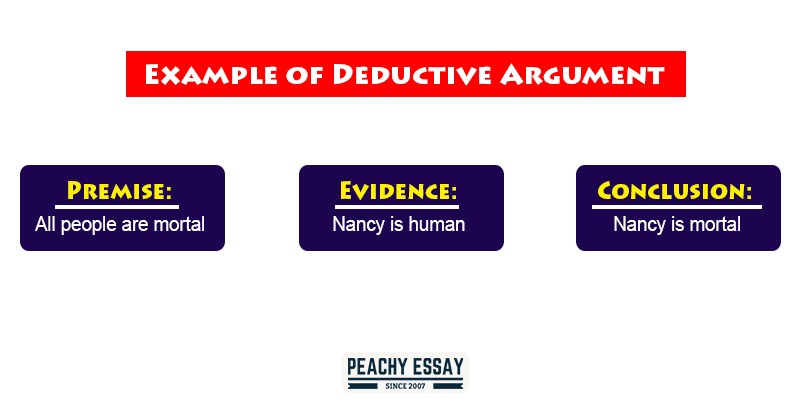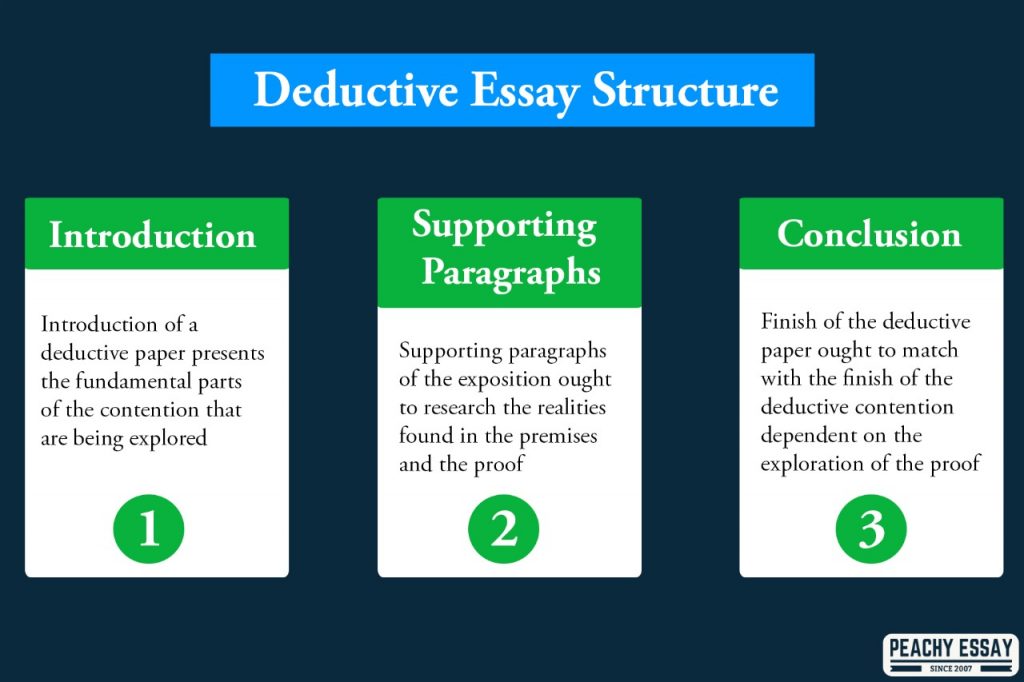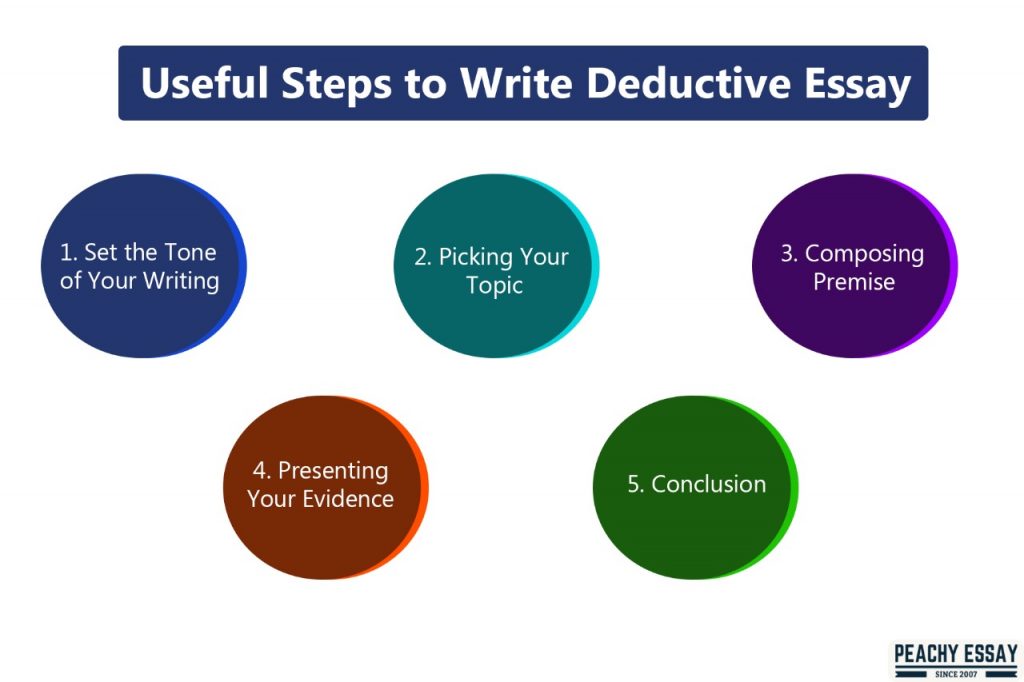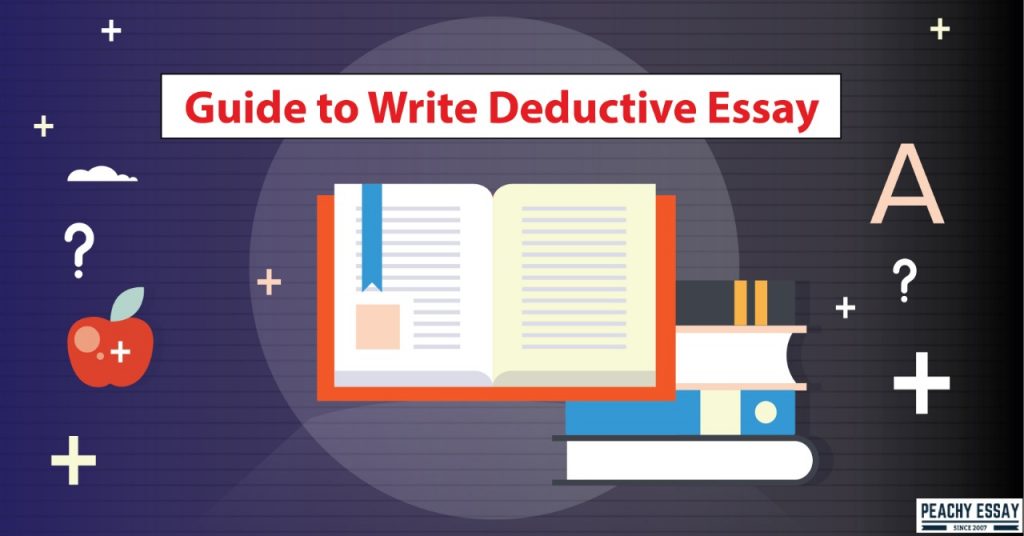A deduction is a method of expressing assumptions, assessments, data that is notable, and afterward applying reasoning to explain and arrive at conclusions. Composing deductive expositions is frequently a challenge for understudies. However, these sorts of articles are a fundamental instrument for tutors to assess how much their understudies comprehend from different courses.
What is a Deductive Essay?
A deductive essay is a kind of article where understudies are obliged to utilize deductive reasoning. Deductive reasoning is the consistent thinking that utilizes general and factual premises to arrive at a particular conclusion.
Deductive reasoning can be clarified as the use of the overall standards that are limited until a specific end is reached. Hence, deductive reasoning is sometimes referred to as “bottom-down logic.” Deductive reasoning is frequently actualized, all things considered, when individuals utilize current facts of the necessary information or the ones that are as of now known to them to arrive at a particular conclusion.
Composing a viable deductive exposition requires the author to execute one’s solid insightful abilities into the development of a deductive contention upheld by adequate proof.
Difference Between Deductive and Inductive Writing
Deductive reasoning is frequently contrasted with inductive reasoning since they address inverse sorts of sensible contentions. Deductive reasoning begins with the overall realities and arrives at explicit resolutions. Then again, inductive reasoning comes at general resolutions by actualizing explicit observations. Consequently, the contrast between deductive and inductive composing is that inductive composing fits the particulars of an inductive contention, though deductive composing follows the design of a deductive contention.
What are Deductive Arguments?
Understudies dealing with a deductive article ought to figure out how to make a deductive contention dependent on deductive reasoning. Deductive reasoning is separated into three sections, including premise, evidence, and conclusion. The premise is the overall certainty that is applied to arrive at a conclusion. In a deductive contention, there could be a solitary reason or a few premises at once. The reason gives a foundation to the coherent contention.
The second piece of a deductive contention is the evidence. The evidence is a piece of more explicit data that addresses the subject of the examination. The evidence will be confirmation that one depends upon in contention and a consistent connection between the premise and the conclusion. The evidence depends on a particular certainty that is noticed or examined by an understudy composing an article. The assumption expressed by the writer of the article ought to be supported up by sound data from insightful sources.
At last, the determination is a summed up examination of the contention that depends on consolidating the premises with the evidence that fills in as definite evidence of the premise. In deductive reasoning, the true premise is an assurance for a genuine conclusion. Thusly, if the premises are false, it is inconceivable for the conclusion to be valid. The conclusion should be balanced and exact. There is an opportunity for a deductive paper to have a huge number of tenable conclusions. If this happens, there is a need to pick an ideal conclusion and spotlight on disclosing it to the reader of the exposition. If the writer of the article decides to zero in on the huge number of determinations, there is a danger for the exposition to be out of focus and not be understood by the reader. The numerical equation for deductive thinking is as follows: If B = C and C= D, then B = D.

This is the fundamental illustration of deductive thinking. Deductive thinking can turn out to be more perplexing if more premises are utilized to arrive at a resolution.
Structure of a Deductive Essay
Like the regular factious article of any sort, the deductive exposition comprises of an introduction, supporting paragraphs, and a conclusion that uncovers premises, proof, and the conclusion of the deductive contention.

Introduction
The introduction of a deductive paper presents the fundamental parts of the contention that is being explored. It is significant for a viable deductive paper to maintain a strategic distance from speculations and to base the introduction of the subject on the realities that are completely examined. Quite possibly, the main piece of the deductive paper is the thesis statement that sums up the significant contentions that are made in the exposition and enveloped with the article’s decision. Your thesis statement must be clear and brief, with no pointless details added. With everything taken into account, a thesis is a short explanation that mirrors the end of contention and the thinking behind it.
Supporting Paragraphs
The supporting paragraphs of the exposition ought to research the realities found in the premises and the proof of the deductive contention. For the comfort of a reader, the realities ought to be explored individually in every one of the paragraphs. It is significant not to flood every one of the sections with an excessive number of contentions for the paper to keep its exact and consistent design.
Conclusion
At long last, the finish of the deductive paper ought to match with the finish of the deductive contention dependent on the exploration of the proof and drawings from the premises of the contention. After the conclusion of the deductive contention is made, the writer can grow the finish of the article by offering potential bearings the contention can take later on. Nonetheless, there is a need to keep the end sensible and brief without plunging into the huge number of future prospects that can’t be upheld by proof.
If one decides not to plunge into the future prospects while finishing up the exposition, there is the likelihood to end it by expressing the potential ramifications of neglecting to settle the issue talked about in the deductive article. If the author decides to follow this pathway, the person ought to stay coherent and concise during the time spent completing the paper, without keeping them from noticing the finish of the deductive contention. The conclusion of the deductive contention needs to remain a vital component of the deductive article conclusion that can’t be overshadowed by different articulations made in the last piece of the exposition.
Steps for Writing a Deductive Essay
Here are the means for composing a deductive article

Set the Tone of Your Writing
Most importantly, you need to consider the tone of your deductive paper. You need to do it objectively and factually, just as consistently stay legitimate when you give your decisions. As such, it is critical to avoid subjective ideas.
Picking Your Topic
Try not to disparage this step! You must be exceptionally mindful and serious when you select the topic for your deductive article. There is a colossal measure of ideas that you can explore; however, you should be cautious. To start with, don’t pick the topics that can make your readers go depressed. When you face challenges and choose to compose on such themes, you must be prepared to remain objective. Second, your deductive article subject must be fascinating and pertinent to your readers.
Composing Premise
The initial segment of the deductive exposition composing measure is the premise. This uncommon method is viable because it makes the subject of your paper all the more intriguing and alluring to your audience. The author needs to utilize this strategy to make the conclusion. It is conceivable to utilize a few premises also. When the author gives a few clues on what the individual will examine in the content, the person in question has a chance to arouse the interest in the intended interest group.
Remember that your deductive exposition’s introduction should plainly clarify the fundamental reason for your paper along with the issue that you will reveal. It is significant to give the background of your topic. Look at your primary inquiry and background completely because this paper ought to be founded on realities.
Try not to pick non-serious inquiries or controversial statements. For example, if your subject alludes to oppressive treatment in the realm of business, utilize the following introductory sentences: ‘The organizations in the business world ought to work equivalent opportunity policies and insurance for all specialists’. Despite the fact that this assertion is sufficiently wide, it is clear in importance. Your intended interest group will concur with it. At that point, you should add more broad details to introduce your theme.
Presenting Your Evidence
In this piece of your deductive article, you should introduce a specific model that is verifiably crucial for this kind of paper. You have a chance to take it from someone’s story or genuine model. After you compose your thesis, you need to give your fundamental contention supporting it with demonstrated realities and models. This proof will fill in as dependable verification for the thesis statement. You should also utilize different logical discoveries in the business world that will add some scholastic tone to the deductive exposition. Your supporting paragraphs ought to incorporate itemized clarifications of the paper’s primary reason.
If we take the very model with prejudicial treatment that we discussed previously, for proof, you can discuss the real instances of biased working environment treatment.
For instance, you can specify that there are various sorts of segregation that specialists face, for example, religion, sex, age, racial and pregnancy. You should make reference to that work environment segregation can come from multiple points of view. This will demonstrate that the organizations in the business world need to provide equal opportunities policies and protection for all workers.
The Conclusion
In a deductive article, moving toward the obvious end result must be the last objective of your work. After you have inspected and examined every one of the solid models and general realities, you need to set up your last contention. If you don’t know that you have given enough proof, you need to return to the proof stage. Indeed you must be completely persuaded that you have given an adequate measure of persuading realities for the conclusion.
If we utilize the case of work environment segregation, it is conceivable to specify in your decision that business organizations should deal with each representative. Despite the fact that this example with work environment segregation is too straightforward, your readers will have a clear idea of the deductive reasoning that you’re utilizing in your composition.
What is a Logical Cognitive Process?
For demonstrating the logical cognitive process in your paper, you’ve to utilize a few realities, (for example, circumstances or clue) for a unique statement. To do it, you’ve to thoroughly consider different elements, and afterward, you’ve to evaluate them other than the realities you definitely know, or you need to demonstrate.
Presently, you may believe, it’s something too difficult to even consider comprehension or stuffs that way, yet truly; it’s just your dread that is holding you back. It resembles addressing math. For instance, you’ve to answer math bafflingly and engagingly, and in each progression, you’ve to provide some insight.
Things You Should Deeply Maintain While Writing a Deductive Essay
Here are a few points you should keep in your psyche even before begin composing.
- Logical way: The deductive paper is about the rationale. You’ve to make a methodology as per your theme and afterward you’ve to stay with it.
- Try not to stress over the conclusion: It’s not the best end kind of exposition. The intention is to build up a rationale that goes with numerous parts of our life. Thus, attempt to set up an engaging piece of the exposition that shows-lovely deductive thinking in it.
- Argument style: You’ve to play cautiously with the contention style. In the event that you know the different sort of contention styles, then it would be entirely agreeable for you. Don’t worry about it! Attempt to get familiar with these two most popular contention style. These two styles are clear cut contentions and propositional contentions.
Argument Styles for Deductive Essay
If you don’t have the foggiest idea of what contention style is, then pulling off a deductive paper is somewhat intense for you. Notwithstanding, here are the main two famous contention style for you. Keep in mind, there are much beyond what you can anticipate.
Categorical arguments: When it comes to rehearsing rationale, the unmitigated contention is something that you ought to follow. It’s most popular for utilizing deductive contentions which we’ve in this exposition. Along these lines, let me give you a thought regarding certain contentions. The most well-known words for it are none, some, and all. In any case, you should need to show three terms in a sentence additionally you can’t show two opposite bits of proof in a sentence.
Propositional arguments: When it comes to propositional contentions, it’s something like caffeine. It keeps the cases on! Well truly, if you’ve been perusing the article till now, then you should’ve understood what I am discussing. Truly, the connector words like and, or and if are the most widely recognized expressions of propositional contentions.
Deductive Essay Writing Tips
Here are the deductive essay writing tips
- Outlining is vital: As you definitely know while composing a deductive paper a great deal of rationale and potential points will spring up in your mind or you may discover a few statements or fundamental realities to remember for the substance. Simply record each one of those! Now plan how you will utilize all these and in which passage you will compose. It’s an incredible method of getting sorted out and making an extraordinary piece of paper.
- Try not to utilize too formal words: Additionally, don’t use any obscene words or adages.
- Try not to show any phony proof for intriguing your educator: Eventually, it’ll cost you more than excellent grades.
- Utilize three-four paragraphs in the proof segment: If you’ve any huge sub-subject to address take a whole article for it!
- Balance the essay: Attempt to follow the 80/20 proportion. 80% in the body and 10+10 in the introduction and conclusion.
- Keeping things directly forthright: Try not to add anything strange to your paper. Attempt to be straight-forward. Likewise, don’t wreck! Attempt to compose as spotless as could be expected. If a thought comes into your head, plan it in a worthwhile, detailed couple of sentences. It’ll assist you with keeping the paper clean.
- Continuously be straightforward while judging. Try not to fake it!
- While utilizing realities or any information in your paper, re-examine it! Investigate the web and attempt to discover the point you need to share is legitimate or not. Attempt to discover something special, energizing, and genuine!
- In case you will add anything, attempt to locate tenable sources of it in any case don’t add it.
- Read more. If you need to shake your paper, there are no options for perusing! Trust us, perusing will assist you with making a sturdy structure, and you’ll additionally comprehend where you should utilize your resources.
- If you can demonstrate another person’s assertion is wrong, remember to utilize this trigger. It’s an incredible methodology, as well.
- With regards to the contention, pick the style first then plan how to pull the argument off!
- Try not to rush! Keep and give enough an ideal opportunity for exploring, composing, and revising too.




